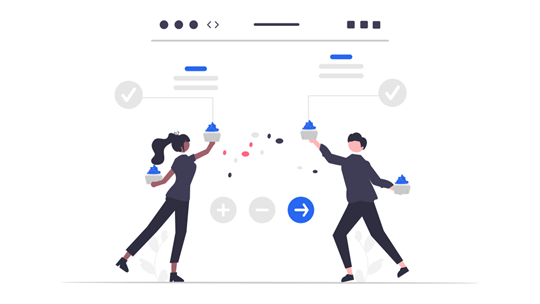Manual Accessibility Testing
When is manual accessibility testing needed?
Keyboard-only navigation
Screen reader compatibility
What makes a good accessibility tester?
There’s a lot to be said for using an automated tool to scan your site for issues that violate WCAG Success Criteria and other accessibility regulations. Most sites are simply too large and complex to comb through by hand and hope to catch every potential accessibility issue. With that said, there are also some key areas where automation is less than optimal.
When is manual accessibility testing needed?
There are many accessibility issues that currently can’t be replicated by a machine or computer program, which makes manual accessibility testing essential for ensuring that your solutions are actually useable for visitors with specific disabilities. This often includes things like keyboard-only commands, compatibility with various assistive technologies, and coordination with color-adjustment plugins for web browsers. Let’s take a look at a few areas where manual testing is especially useful.
Keyboard-only navigation
Being able to navigate and operate all of a website’s functions without the use of a mouse is essential for many users with disabilities, especially those who use certain assistive tools. Manual accessibility testing can help you determine if your site is optimized for keyboard-only functionality such as:
- Moving between sections of a web page
- Accessing all menus
- Top-of-page links that allow users to skip directly to each page’s vital content
- Links and form fields that can be highlighted using keyboard commands
Screen reader compatibility
Screen readers are among the most commonly used assistive tools for users with low vision, and there are key differences between each of the leading models. Manual testing is useful to determine how readable your content is for various assistive technologies, as many assistive situations—navigating menus, determining where links lead, or understanding the context of alternative text, for instance—are difficult to replicate in an automated setting.
- Color adjustments - While automated scans and browser plugins can be helpful in catching problematic color-contrast issues that make comprehension difficult for some users, most of these scans can’t detect contrast ratio images related to background images. Manually testing each area of your website against established standards can help make sure your content is understandable to a broader range of users.
- Page titles - The proper use of page titles can be a tricky prospect. While an automated scan can usually identify pages that are missing titles, it can’t determine their context or usefulness. A manual tester can help ensure that titles provide the meaning of the page in a clear, concise way that’s compatible with both assistive technology and search engine crawlers.
- Proper coding - Some elements of accessibility are not evident on the consumer side. Ensuring that HTML5 and WAI-ARIA elements are properly employed for maximal accessibility will often require a manual check by someone familiar with coding best practices.
What makes a good accessibility tester?
One of the major benefits of manual accessibility testing is the same as the upside of any kind of editing—getting a new viewpoint on the material. In this case it’s the difference between computerized scanning and human observation. As advanced as software technology is, there are still plenty of situations where an algorithm can’t recognize the nuances necessary to building a website that works for people of varying abilities.
Manual accessibility testing should be performed by trained professionals with expertise in the subject. Users with experience in keyboard-only navigation, browser plugins, and assistive technology will be able to identify areas where your website is behind the curve and offer solutions.
A manual accessibility tester should also be familiar with the latest standards for online accessibility. Keeping your website compliant with WCAG 2.1 Level AA accessibility standards is the ultimate goal, so employing a tester who understands both the manual needs of disabled users and the internationally respected standards of WCAG is essential.
The bottom line for most websites is that the surest path to accessibility is a combination of automated and manual testing. There are just some areas that are handled more efficiently by humans than machines, and vice versa. Automated accessibility checking is ideal for getting a comprehensive overview of accessibility issues across your entire digital presence, while manual testing is needed in cases where issues require human assessment.
As always, it’s important to remember that maintaining an accessible website is an ongoing project. Just as automated scans should be run at scheduled intervals, manual accessibility testing should be a regular part of your website maintenance.
Wir beantworten Ihre Fragen gerne.
Die Zusammenarbeit mit einem neuen Technologiepartner ist eine wichtige Entscheidung. Wir sind hier, um alle Fragen zu beantworten, die Sie haben.
Beratungstermin vereinbaren